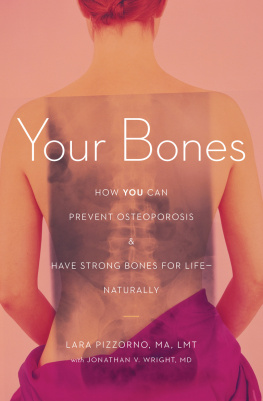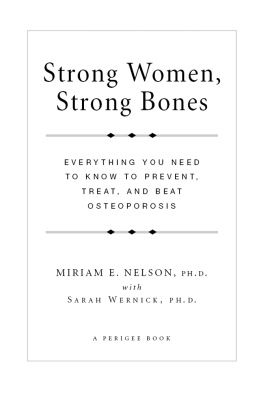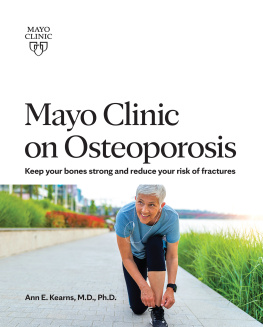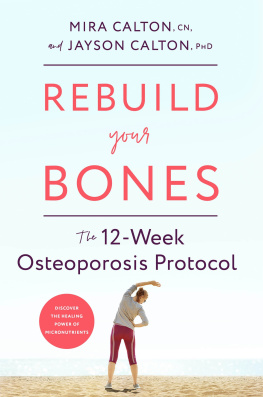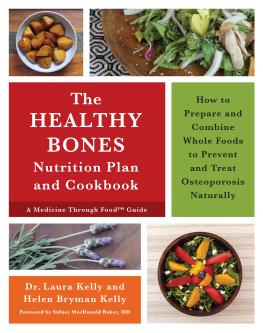Praise for Your Bones
This is a book filled with wisdom and information written in a style which is easy to understand and put to use. I heartily recommend it to all those who care about maintaining a healthy body.
Bernie Siegel, MD, Author of Faith, Hope & Healing and 365 Prescriptions For The Soul
Your Bones is a down-to-earth guide to osteoporosis, one of the most common health challenges of modern life. If you are 30 or older, you cannot afford to ignore the wisdom in this book.
Larry Dossey, MD, Author of The Science of Premonitions, Healing Words, and Reinventing Medicine
This superb text explains the causes and solutions of osteoporosis, and its associated problems, comprehensively, clearly and accurately. Despite the complexity of the condition, this is an easy read, with no dumbing down of the contentbrilliantly highlighting safe, natural, and effective prevention and treatment strategies. Highly recommended.
Leon Chaitow, ND, DO, Honorary Fellow, University of Westminster, LondonEditor-in-Chief, Journal of Bodywork & Movement Therapies
This is one of the best books ever written on bone healthabsolutely fantastic! In this book , Lara Pizzorno, MA provides scientifically based advice for men and women of all ages to help them develop and maintain strong healthy bones. She makes a complex issue easily comprehensible and provides information that empowers the reader to take measures towards ensuring their own bone health. I highly recommend it.
George Mateljan, Philanthropist, Author of the book, The Worlds Healthiest Foods
I found Your Bones by Lara Pizzorno to be highly readable, provocative and often persuasive. Do, please, read this book. It is full of startling insights into the nature of age-related bone loss.
Peter DAdamo, ND, MIFHI
Everything you need to know for healthy bones in one book. Packed with facts, this book is as easy to read as the tips and insights to bone-building living are easy to implement. Informative and inspiring.
Lani Lopez, BHSc, Adv Dip Nat
Part 1
You Are at Risk for Osteoporosis
Chapter 1
If You Are a Woman, Youre at High Risk for Osteoporosis
What Is Osteoporosis?
Osteoporosisliterally, porous bone (osteo = bone, porosis = porous)is a progressive loss of bone that results in bone thinning and increased vulnerability to fracture. Osteoporotic fracturesalso called fragility fractures because they happen in thinned out, fragile boneoccur primarily in the wrist, rib, spine, and hip, often during daily activities, such as stepping off a curb, which should normally pose no risk for a fracture.
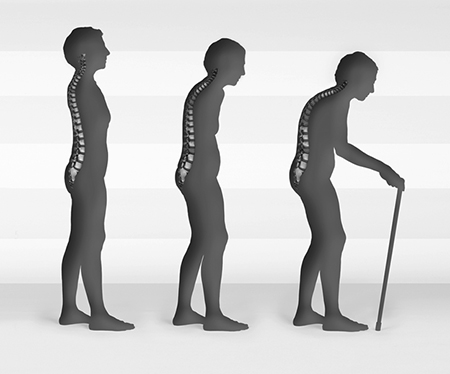
Why Are Women at Higher Risk Than Men of Losing Too Much Bone?
For two key reasons:
First, women start out with less bone than men. Womens peak bone mass is naturally less than mens because women are smaller and have less muscle. When we use our muscles, the muscle contractions put stress on bone, to which it responds by becoming stronger. Mens larger muscles produce stronger contractions, resulting in more stress and approximately 3540% larger bones.
Secondly, the female hormones, estrogen and progesterone, play vital roles in bone remodeling, and levels of both hormones drop with menopause (medically defined as the last menstrual period); for most women in the Western world, the median age for menopause is 51, but the range for its onset is largegenerally between ages 42 and 58. Estrogen prevents excessive action by osteoclasts , specialized bone cells that remove worn out or dead bone to make room for new bone. Progesterone is required by osteoblasts , the bone-forming cells that pull calcium, magnesium, and phosphorous from the blood to build new bone. Production of both hormones greatly declines during a womans transition through menopause, resulting in increased bone resorption and decreased formation of new bone.
Am I Really at Risk? How Common Is Osteoporosis?
If you are a woman, the answer is emphatically Yes! One in four women will develop osteoporosis after menopause. Lifetime risk for fragility fractures, an indicator of osteoporosis, is 50% in women versus 25% in men. Twenty-five million Americans have osteoporosis or are at significant risk for it. Osteoporosis is responsible for at least 1.5 million fractures each year, including 250,000 hip fractures.
Men Are Not Immune to Osteoporosis
Although women are most at risk, 2533% of men will experience an osteoporotic fracture in their lifetime. In men, however, the rapid increase in fracture risk begins later, at approximately age 70.
What Are My Chances of Recovering from a Hip Fracture Due to Osteoporosis?
Nearly one-third of all women and one-sixth of all men will suffer an osteoporotic hip fracture. The most catastrophic of fractures, hip fracture leads to death in 1220% of cases and long-term nursing home care for over 50% of those who survive.
Men fare even worse than women after a hip fracture: a womans risk of death doubles, a mans risk more than triples. For virtually everyone who suffers an osteoporotic hip fracture, life never returns to normal.
This is something you definitely want to prevent, and fortunately you can, but not by relying on the patent medicines (also called pharmaceuticals and/or drugs) prescribed to prevent osteoporosis.
Part 2
Why Conventional Medicine Is Not the Answer for Strong Bones
Chapter 2
The Patent Medicines Prescribed to Prevent Osteoporosis Should Be Your Last Choice for Healthy Bones
Its true, as Sally Field emphasizes in her TV ads for Boniva, that you have only one body. Its not true that Boniva or the other bisphosphonate patent medicines commonly prescribed to prevent osteoporosis offer the best way to take care of it!
Patent Medicines
Patent medicines are not a relic of the past! Theyve been with us all our lives. The overwhelming number of prescriptions written in the United States for the entire 20th century and thus far in the 21st century have been for written for patented or formerly patented substances. Even though todays gigantic patent medicine companies try their best to disguise this obvious fact by calling their products pharmaceuticals, theyre still just patent medicines under another name.
All patent medicines have the same basic problem by law: a patent can only be granted for substances never, ever found in human bodies or anywhere else on planet Earth. Although it sounds strange, its literally true to say that patent medicines are extraterrestrial, space alien substances!
Since our bodies were designed (or evolved) from entirely natural materials, patent medicines are fundamentally incompatible with design of the human body. Its no wonder more than 100,000 Americans die from patent medications every year, and hundreds of thousands more experience serious adverse effects. By contrast, according to the most recent report of the American Association of Poison Control Centers, not a single American died in 2008 from the use of vitamins, minerals, amino acids, essential fatty acids, hundreds of other supplemental nutrients, or any of thousands of herbal products.
Given this enormous difference in safety, why arent medical research and medical practice focused on safe and effective natural substances? Youve heard of follow the money? Here it is again: Because of that patent, no competition is allowed, so patent medicines that cost 98 a unit to produce can be (and are) sold for $98 a unit (100 times their cost), or more. Natural substances are also sold at a profit, but competition limits the profit margin to 2 to 3 times cost of production. Predictably, the focus of patent medicine (pharmaceutical) companies is profit, first and foremost. Your health is a secondary goal.

